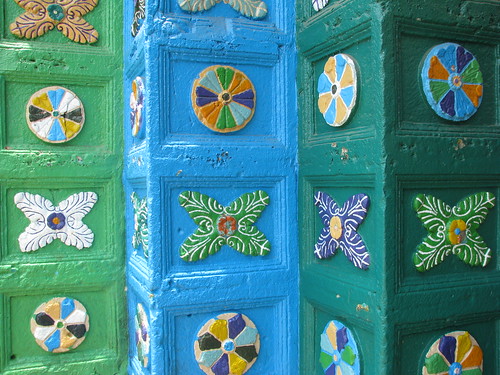Templo de San Juan is home to the fiercely independent Chamulans, a subgroup of Mayans. Beside the plaza filled with vendors is their main church, this is one of the few churches I’ve been to that charges admission (20 pesos). Go down to the town office to purchase the 8×11″ certificate ticket.


The local form of Catholicism is a blend of pre-conquest Maya customs, Spanish Catholic traditions, and subsequent innovations.The only Catholic function carried on in the church seems to be baptisms. Otherwise the practices are still Mayan in origin. With no pews, people kneel on the floor covered in pine needles. Curanderos (medicine men) diagnose medical, psychological or ‘evil-eye’ afflictions and prescribe remedies such as candles of specific colours and sizes, specific flower petals or feathers, or – in a dire situation – a live chicken. The specified remedies are brought to a healing ceremony. Chamula families kneel on the floor of the church with sacrificial items, stick candles to the floor with melted wax, drink ceremonial cups of Posh, artisanal sugar-cane-based liquor, and chant prayers in an archaic dialect of Tzotzil. Everybody is chanting.

Glassed cases with Catholic saints line the walls. Thousands of candles are burning and along with the smoke from burning copal resin incense, produces the smoky, wax smell. Candles in glasses cover multiple tables in front of the effigies and thousands, from birthday sized to large, are stuck onto the floor. Headless chickens and yucca flowers adorn the walls. Pictures are forbidden inside the church and the locals resent their pictures being taken.


San Juan Chamula is a township (elevation 2,200m), some 10 km (6.2 mi) from San Cristóbal de las Casas. As of 2010, the municipality had a total population of 76,941 is indigenous Tzotzil Maya people, speaking the Tzotzil language, a Mayan language. Of 149 localities in the municipality, the town (3,349 pop), enjoys unique autonomous status within Mexico. No outside police or military are allowed in the village. Chamulas have their own police force. One of the best ethnographic descriptions of Chamula in English is Chamulas in the World of the Sun by Gary H. Gossen.
The main agricultural products are corn, beans, potatoes, and cabbage. Women often make traditional clothing, blankets, and souvenirs that include Zapatista-related items, such as pens with a clay figure on top in the figure of Subcomandante Marcos or Comandante Tacho.
Local dress is distinctive with men wearing thick black wool tunics and the women in heavy wool pleated skirts, lavishly embroidered satin blouses and light cardigans. Conflicts between adherents to traditional Chamulan religion and converts to Protestantism have resulted in the expulsion of thousands of Chamulans from their villages, and they now inhabit the shantytowns around San Cristobal de las Casas.
The area is particularly busy on Sundays because the town holds a large open air market on the square in front of the church. Tens of thousands visit the church each year on June 24th, the Saint’s Day of St. John the Baptist.
Photography in the town is very difficult as parents will hide their children or they themselves will turn away as soon as they spot a camera. Photography within the church is strictly prohibited as is photographing the Christmas procession to the church. They can throw you out of town if you attempt to violate this rule.